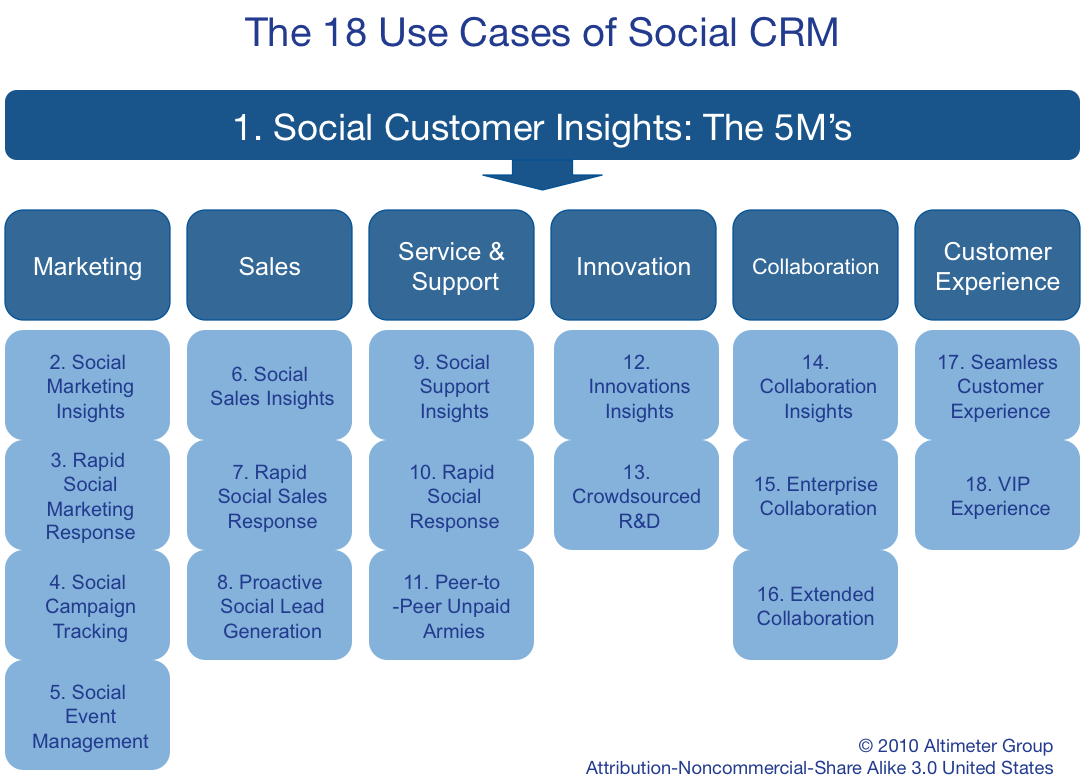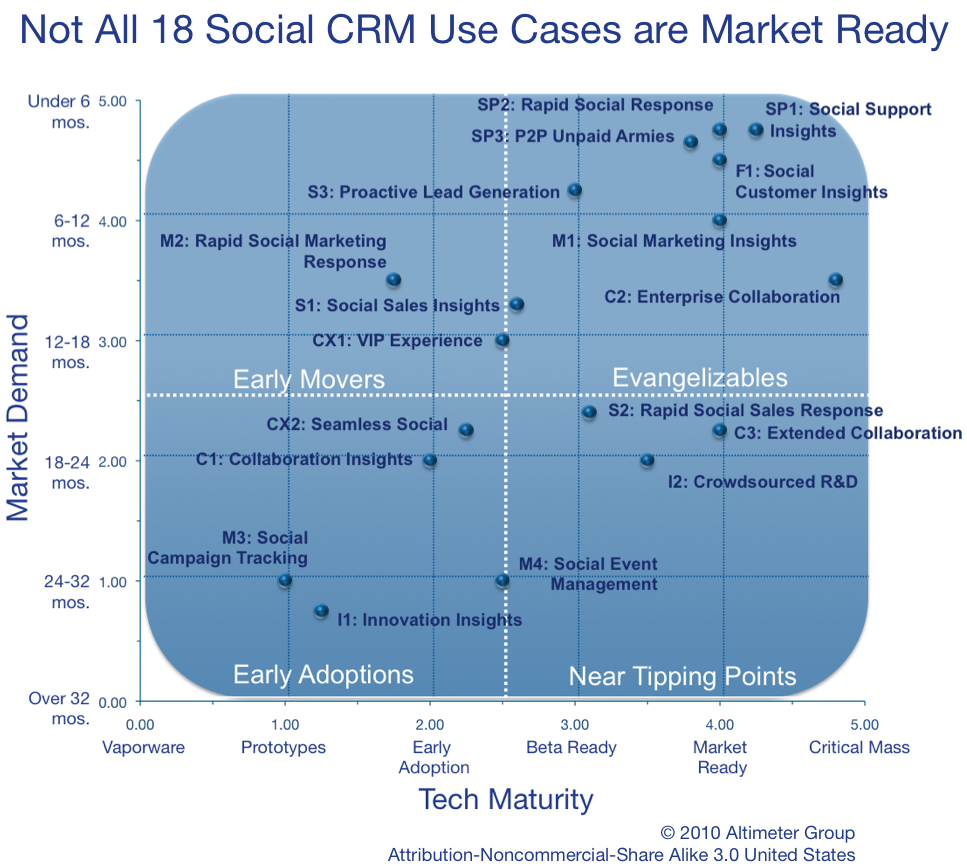 |
| Image Source: Flickr |
I woke up this Saturday morning, yet again, to an important announcement that was made the evening of the US’ Friday. And I find the world changed yet again. 🙂
I am of course talking about the humongous report on what consists of Social CRM at the moment that the Altimeter group has come out with – “Social CRM: The New Rules of Relationship Management“.
Put together by Ray Wang & Jeremiah Owyang after talking to a huge cross section of the influencers & vendors in Social CRM and a hundred pioneers, the report captures the zeitgeist of the Social CRM landscape and provides the 18 use cases that they recognized! The talking alone would have drained me, but these guys talked & even made sense out of it all! And to top it all, they make it very easy to understand. 🙂
 |
| Image Source: Flickr |
The 18 use cases is a good starting point & helps businesses to figure out where they could get started with Social CRM, if they already do not know. Most businesses that I had talked to do have a clue where it could possibly help their business, but not sure how to do it as part of a business strategy. So they are left to resort to some patch work of tactics. The 18 use cases list would help the businesses have an epiphany.
But the report doesn’t stop there. It also gives you the state of the IT enablers as of today.
Don’t get me wrong. IT has been sullied a lot in the previous round of CRM buzz due to the various failed projects, and then finally it dawned on the business world that CRM is not about the software as the vendors led them to believe, but CRM is a business philosophy.
This does not change with Social CRM – its also about the business philosophy, about being customer centric. However, this round its been forced upon the businesses because of the advances in the social web – or rather the adoption of the advances in technologies by the customers. So it is imperative that IT gets into the equation, however they cannot dictate how to do it. IT’s role is to help the business with the infrastructure. And so why IT is part of the decision making process, it does not drive it.
Ok, getting down from my soapbox, lets see why the Altimeter report is important from an IT perspective.
 |
| Image Source: Flickr |
They actually talked to the vendors in the fray to provide Social CRM solutions (even if they do not claim or realize to be in the fray) and rated their wares. The matrix they have created (Magic Quadrant?) is very good in stating which are the technologies that the businesses can have right now as well as which are the technologies that businesses are willing to buy, by when. A great tool for both vendors as well as businesses [very similar to a MQ I had in our innovations team to help figure out which are the ideas we should invest in to convert them into Innovations].
This is a very key babystep in furthering the field of Social CRM. Comes right next to the stake in the ground on the definition of Social CRM by Paul Greenberg, which I see as an academic definition that most practitioners derive from to fit their purposes, including myself and our team. There is no one present who can cater to the whole gamut that Paul’s definition encompasses.
The use cases are a key intermediary step in furthering the understanding of the field and convert into an application in the business.
Businesses need to then figure out how to implement it – whats the methodology, what frameworks are available, whats the governance model. This is what keeps me busy right now. 🙂
P.S.: I am very glad that Altimeter decided to release this report under the Creative Commons license! So please feel free to reuse it, but don’t you try to sell it off as yours & cheat Altimeter. Always attribute it to them and don’t take money for the report.




Hi Prem
The Altimeter report certainly has caused a stir in the SocCRM community. It provides us a service by listing and describing a number of use cases for SocCRM tools. But for all its usefulness, the Altimeter report has a number of significant flaws too.
Firstly, it is almost entirely written from the company’s perspective. And is largely focussed on the traditional inside-out CRM disciplines of marketing, sales and service. A large part of why CRM has not delivered the goods for companies in the past is that it has been focussed solely on companies and not on their customers. CRM treated customers as little more than targets to be relieved of their money. Customers, of course, resented being treated as walking wallets. Wouldn’t you? The Altimeter report is conspicuous by its silence over what jobs customers use social media to do and what outcomes they are looking for by using it, and thus, how companies should look to engage with customers. It is engagement, as Paul Greenberg said recently, that is the key here, not business functions or SocCRM tools.
Secondly, it ignores what caused CRM to fail and thus perpetuates the same old problems. As is widely recognised today, one of the big reasons why CRM failed was because it only pulled some of the levers of successful business change. Many companies simply bought and implemented CRM software without any real thought about: how processes should change to leverage it, what new data would be required, how new roles and responsibilities should be structured, how business performance should be measured and so on. These companies lived out the old dictum: Old Organisation + New Technology = Expensive Old Organisation. The Altimeter report perpetuates this problem by treating SocCRM as just a more networked form of bad old CRM; CRM + Social = SocCRM.
Finally, it doesn’t tackle the fundamental problems that have caused customers to reach out to each other for help and assistance through their social networks. Most of the leading social customer ‘solutions’ have been created by customers for each other. Whether to complain at crap companies and their shoddy products, to seek advanced product support or just to swap success stories, these solutions have been created because of the failure of companies to provide reliable products, honest sales pitches, decent after-sales support or even somewhere to be a fan. Necessity is the mother of invention as the old saying goes. By not recognising how companies are failing customers – often in easy to remedy ways – the Altimeter report sets the barrier too low for companies to jump over.
I originally wrote my Manifesto for SocBiz in response to these types of report. I was, and am fed up of SocCRM been positioned as just CRM with Social tools tacked on. This is a gross simplification. SocCRM can and should be about much more than just Marketing, Sales and Service. Or even collaboration and innovation. It should be about engaging customers in a meaningful dialogue around what jobs customers are trying to do, what sort of solutions they would benefit from, which resources need to be brought together to provide them and how to do this so that companies can make a profit too.
The Altimeter report is great for what it does – provides a number of easy use cases around SocCRM tools – and congratulations to Ray and Jeremiah for producing it. But it is the larger omissions that should give us all cause for concern. It is these omissions that will cause companies to fail at SocCRM in the future, just as so many have at CRM in the past.
Graham Hill
Customer-centric Innovator
@grahamhill
PS. I know what you are thinking: Sorry, but I am too busy doing SocCRM for my clients to write about it these days.
Interested in Customer Driven Innovation? Join the Customer Driven Innovation groups on LinkedIn or Facebook to learn more.